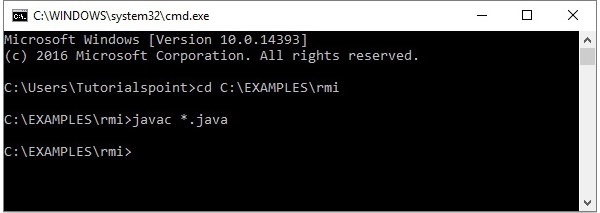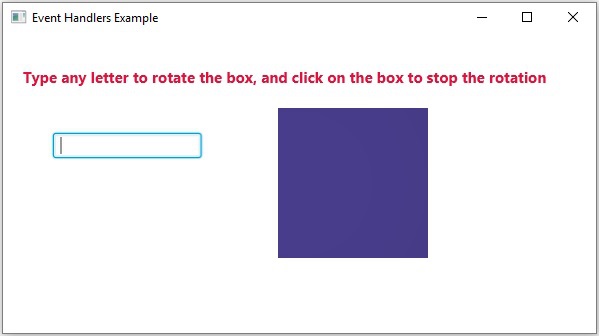Java RMI - Aplicativo GUI
No capítulo anterior, criamos um aplicativo RMI de amostra. Neste capítulo, vamos explicar como criar uma aplicação RMI onde um cliente invoca um método que exibe uma janela GUI (JavaFX).
Definindo a Interface Remota
Aqui, estamos definindo uma interface remota chamada Hello com um método chamado animation() iniciar.
import java.rmi.Remote;
import java.rmi.RemoteException;
// Creating Remote interface for our application
public interface Hello extends Remote {
void animation() throws RemoteException;
}Desenvolvendo a Classe de Implementação
Na classe Implementation (Remote Object) desta aplicação, estamos tentando criar uma janela que exibe o conteúdo da GUI, utilizando JavaFX.
import javafx.animation.RotateTransition;
import javafx.application.Application;
import javafx.event.EventHandler;
import javafx.scene.Group;
import javafx.scene.PerspectiveCamera;
import javafx.scene.Scene;
import javafx.scene.control.TextField;
import javafx.scene.input.KeyEvent;
import javafx.scene.paint.Color;
import javafx.scene.paint.PhongMaterial;
import javafx.scene.shape.Box;
import javafx.scene.text.Font;
import javafx.scene.text.FontWeight;
import javafx.scene.text.Text;
import javafx.scene.transform.Rotate;
import javafx.stage.Stage;
import javafx.util.Duration;
// Implementing the remote interface
public class FxSample extends Application implements Hello {
@Override
public void start(Stage stage) {
// Drawing a Box
Box box = new Box();
// Setting the properties of the Box
box.setWidth(150.0);
box.setHeight(150.0);
box.setDepth(100.0);
// Setting the position of the box
box.setTranslateX(350);
box.setTranslateY(150);
box.setTranslateZ(50);
// Setting the text
Text text = new Text(
"Type any letter to rotate the box, and click on the box to stop the rotation");
// Setting the font of the text
text.setFont(Font.font(null, FontWeight.BOLD, 15));
// Setting the color of the text
text.setFill(Color.CRIMSON);
// Setting the position of the text
text.setX(20);
text.setY(50);
// Setting the material of the box
PhongMaterial material = new PhongMaterial();
material.setDiffuseColor(Color.DARKSLATEBLUE);
// Setting the diffuse color material to box
box.setMaterial(material);
// Setting the rotation animation to the box
RotateTransition rotateTransition = new RotateTransition();
// Setting the duration for the transition
rotateTransition.setDuration(Duration.millis(1000));
// Setting the node for the transition
rotateTransition.setNode(box);
// Setting the axis of the rotation
rotateTransition.setAxis(Rotate.Y_AXIS);
// Setting the angle of the rotation
rotateTransition.setByAngle(360);
// Setting the cycle count for the transition
rotateTransition.setCycleCount(50);
// Setting auto reverse value to false
rotateTransition.setAutoReverse(false);
// Creating a text filed
TextField textField = new TextField();
// Setting the position of the text field
textField.setLayoutX(50);
textField.setLayoutY(100);
// Handling the key typed event
EventHandler<KeyEvent> eventHandlerTextField = new EventHandler<KeyEvent>() {
@Override
public void handle(KeyEvent event) {
// Playing the animation
rotateTransition.play();
}
};
// Adding an event handler to the text feld
textField.addEventHandler(KeyEvent.KEY_TYPED, eventHandlerTextField);
// Handling the mouse clicked event(on box)
EventHandler<javafx.scene.input.MouseEvent> eventHandlerBox =
new EventHandler<javafx.scene.input.MouseEvent>() {
@Override
public void handle(javafx.scene.input.MouseEvent e) {
rotateTransition.stop();
}
};
// Adding the event handler to the box
box.addEventHandler(javafx.scene.input.MouseEvent.MOUSE_CLICKED, eventHandlerBox);
// Creating a Group object
Group root = new Group(box, textField, text);
// Creating a scene object
Scene scene = new Scene(root, 600, 300);
// Setting camera
PerspectiveCamera camera = new PerspectiveCamera(false);
camera.setTranslateX(0);
camera.setTranslateY(0);
camera.setTranslateZ(0);
scene.setCamera(camera);
// Setting title to the Stage
stage.setTitle("Event Handlers Example");
// Adding scene to the stage
stage.setScene(scene);
// Displaying the contents of the stage
stage.show();
}
// Implementing the interface method
public void animation() {
launch();
}
}Programa de Servidor
Um programa de servidor RMI deve implementar a interface remota ou estender a classe de implementação. Aqui, devemos criar um objeto remoto e vinculá-lo aoRMIregistry.
A seguir está o programa do servidor deste aplicativo. Aqui, vamos estender a classe criada acima, criar um objeto remoto e registrá-lo no registro RMI com o nome de ligaçãohello.
import java.rmi.registry.Registry;
import java.rmi.registry.LocateRegistry;
import java.rmi.RemoteException;
import java.rmi.server.UnicastRemoteObject;
public class Server extends FxSample {
public Server() {}
public static void main(String args[]) {
try {
// Instantiating the implementation class
FxSample obj = new FxSample();
// Exporting the object of implementation class
// (here we are exporting the remote object to the stub)
Hello stub = (Hello) UnicastRemoteObject.exportObject(obj, 0);
// Binding the remote object (stub) in the registry
Registry registry = LocateRegistry.getRegistry();
registry.bind("Hello", stub);
System.err.println("Server ready");
} catch (Exception e) {
System.err.println("Server exception: " + e.toString());
e.printStackTrace();
}
}
}Programa Cliente
A seguir está o programa cliente deste aplicativo. Aqui, estamos buscando o objeto remoto e invocando seu método denominadoanimation().
import java.rmi.registry.LocateRegistry;
import java.rmi.registry.Registry;
public class Client {
private Client() {}
public static void main(String[] args) {
try {
// Getting the registry
Registry registry = LocateRegistry.getRegistry(null);
// Looking up the registry for the remote object
Hello stub = (Hello) registry.lookup("Hello");
// Calling the remote method using the obtained object
stub.animation();
System.out.println("Remote method invoked");
} catch (Exception e) {
System.err.println("Client exception: " + e.toString());
e.printStackTrace();
}
}
}Etapas para executar o exemplo
A seguir estão as etapas para executar nosso Exemplo de RMI.
Step 1 - Abra a pasta onde você armazenou todos os programas e compile todos os arquivos Java como mostrado abaixo.
Javac *.java
Step 2 - Comece o rmi registro usando o seguinte comando.
start rmiregistry
Isso vai começar um rmi registro em uma janela separada, conforme mostrado abaixo.

Step 3 - Execute o arquivo de classe do servidor conforme mostrado abaixo.
Java Server
Step 4 - Execute o arquivo de classe do cliente conforme mostrado abaixo.
java Client
Verification - Assim que você iniciar o cliente, verá a seguinte saída no servidor.
